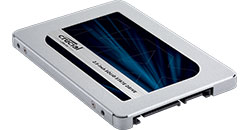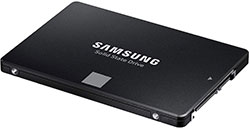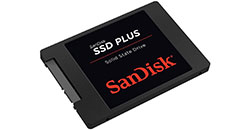Comparison of 2.5-inch SATA SSD best sellers – SSD recommendations and shopping tips
Crucial MX500
- best value 2.5″ SATA SSD drive
- 250 GB to 2 TB (2,000 GB)
- up to 560 MB/s read speed
- up to 510 MB/s write speed
- 5 years limited warranty
Samsung SSD 870 EVO
- best seller 2.5″ SATA SSD drive
- 250 GB to 4 TB (4,000 GB)
- up to 560 MB/s read speed
- up to 530 MB/s write speed
- 5 years limited warranty
SanDisk SSD Plus
- best price 2.5″ SATA SSD drive
- 120 GB to 2 TB (2,000 GB)
- up to 535 MB/s read speed
- up to 450 MB/s write speed
- 3 years limited warranty
shop around for best 2.5-inch SATA SSD worldwide on | Amazon.com #ad | computeruniverse.net | eBay.com | AliExpress.com |
- ADS -
What is a SATA SSD?
A SATA SSD is an SSD that is connected to the system using a SATA connector. The 2.5-inch form factor with dimensions of 70 x 100 mm has become the most popular design for SATA SSDs. With an overall height of 7 mm, the modern flash memories find their place in both desktops and laptops. The SATA interface is the long-standing standard for the connection of storage media such as SSD and conventional hard drives, as well as optical drives. Today, the third version of the SATA protocol, also known as SATA 6Gb/s or SATA III, is used. The latest generation of the SATA interface is also backward compatible to the older versions.
What are the advantages of a SATA SSD?
A decisive advantage of SATA SSD hard disks is the widespread use of the SATA interface. Thus the desktop motherboards usually have a large number of such. Also in many older and most newer laptops you will find a SATA connector. In addition, the modern SATA SSDs can also be used in older systems thanks to their compatibility (backwards compatible with SATA 1.5 Gb/s and SATA 3.0 Gb/s). A further advantage of SATA SSDs is their price/performance ratio, as they are at an attractive price level compared to SSDs with other interfaces, and also offer performance that is perfectly adequate for normal users. In addition, SATA SSDs allow comparatively high capacities because the form factor allows many memory chips to be accommodated in one drive.
What are the disadvantages of a SATA SSD?
A decisive disadvantage of SATA SSD hard disks is the SATA interface itself, since no further performance leaps are to be expected here due to the limited performance. Whereby it should be noted that the read and write speeds of a SATA SSD are also more than excellent for many users in everyday use, especially compared to a conventional hard disk. A further disadvantage of SATA SSDs is the form factor used and the resulting dimensions, which limit their use in the particularly flat and mobile Ultrabooks.
For whom is a SATA SSD the right choice?
A SATA SSD is the right recommendation and worth a purchase tip for every price-conscious normal user. A prerequisite for the installation or retrofitting of a SATA SSD is a free SATA port on the mainboard in the desktop PC or an existing 2.5-inch installation slot in the laptop or ultrabook. In addition, the use of a SATA SSD in a corresponding housing as an external drive is conceivable.


